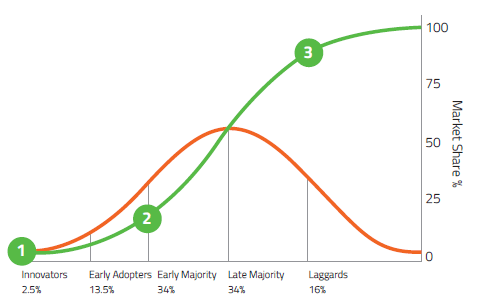The release of reserve ndau into the marketplace follows a well-defined technology growth pattern. This growth occurs naturally along an S-curve as modeled in the Diffusion of Innovations theory – a theory which seeks to explain how, why, and at what rate new ideas and technologies spread. Individuals have different levels of readiness for adopting new innovations; the average rate of this adoption is, of course, influenced by the characteristics of the product itself. The theory classifies individuals into five tiers: Innovators, Early Adopters, Early Majority, Late Majority, and Laggards.

Innovators occupy the first 2.5 percent of the S-curve, while Early Adopters represent 13.5 percent. Early Majority Adopters and Late Majority represent 34 percent each while Laggards make up the final 16 percent of the curve. The adoption rate of ndau drives the release of the 30 million reserve ndau into the market: the S-curve illustrates the total amount of ndau in circulation as adoption moves from 0 percent to 100 percent.
RELEASE SCHEDULE
ndau uses the Diffusion of Innovations theory in its release of ndau and its pricing schedule. To facilitate the adoption rate of the currency in an orderly, efficient, and transparent manner, the 30 million reserve ndau originally held in the Endowment will be sold into the market according to a transparent, pre-determined Next Issue Price schedule. The Axiom Foundation’s distribution of new ndau at a higher price occurs only when market demand exceeds supply – i.e. when there is a willingness to buy at a new Next Issue Price that’s greater than anyone is willing to sell. Hence, movement up the price curve reflects that market demand is ready to support a higher price. This is in contrast to many proof-of-work cryptocurrencies that steadily increase supply at a regular frequency irrespective of the demand or price at any given time. As network effects naturally increase the value of ndau and as the total number of reserve ndau released follows the S-curve, the Next Issue Price rises as market participants demonstrate demand at those levels.
The Next Issue Price Curve can be broken into three phases in which ndau will be released: Early Adoption, Middle Market, and Equilibrium. Ten million reserve ndau are scheduled for release throughout each individual phase along the S-curve for a total of 30 million ndau. As the market accepts and adopts the currency along the S-curve, increasing the value due to positive network effects, the Next Issue Price at which the Axiom Foundation sells ndau rises. The Next Issue Price rises most rapidly in the Early Adoption phase and more slowly as adoption approaches 100 percent on the S-curve.
The first 10 million reserve ndau are scheduled for sale during the high growth phase as Innovators and Early Adopters begin using the currency as a long-term store of value. The goal of this phase is to encourage such innovators and early adopters to commit towards the ndau ecosystem, aggressively competing for a position of leadership for ndau in the digital currency marketplace.
As ndau evolves toward wider market adoption, the transitional Middle Market growth phase occurs and 10 million more reserve ndau are scheduled to enter the market at more moderate price increments, as demand warrants. Growth in Next Issue Price then slows further in the final Equilibrium phase during which the last 10 million reserve ndau enter the market. Network effects grow the value of ndau more modestly since the value of those effects diminishes on the margin. This is indicative of the currency reaching full acceptance in its addressable market as it begins to reach the natural limits of market desire to store value in such a long-term form.